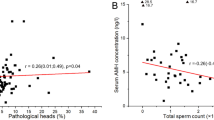Summary
A high intensity of lectin bindings was demonstrated on the epithelial cells and serosa cells of the regressing right Mullerian ducts (Mds) in the female chick embryos. The strong lectin bindings occurs on, or in the regressing Md cells along with marked surface MIS bindings at the age of day 13. However, at the age of days 5–7 1/2, bindings of lectins were weak. Neither Wheat-germ agglutinin (WGA) or Concanavalin A (Con-A) labelings before MIS-antiserum (MIS-Ab) incubation can block antibody recognitions to the antigens, including MIS and growth hormone at the age of day 13. Our previous studies indicated that after WGA labeling on the surfaces of Md epithelial cells prior to the incubation of MIS-Ab at day 10 did not prevent the recognition of MIS-Ab (Wang 1989). On the contrary, at day 7 1/2, the specific binding of MIS was eliminated after preincubations with lectins and prenatal diethylstilbestrol (DES) treatment at the age of day 5. It is suggested that DES provides a protection to the Mds from MIS-induced regression by preventing the MIS binding to its specific membrane receptors. An increase of extra- and intracellular glycoproteins or carbohydrates of regressing Md epithelial cells were suggested. Internalization of WGA but not MIS molecules was found in Md epithelial cells. The Golgi saccules were negative of lectin bindings.
Similar content being viewed by others
References
Arakawa K, Grumberger G, McElduff A, Gorden P (1985) Polypeptide hormone receptor phosphorylation: is there a role in receptor-mediated endocytosis of human growth hormone? Endocrinology 117:613–637
Behringer RR, Cate RL, Froelick GJ, palmiter RD, Brinster RL (1990) Abnormal sexual development in transgenic mice chronically expressing Mullerian inhibiting substances. Nature 345:167–169
Coughlin J, Donahue PK, Budzik GP, MacLaughlin DT (1987) Mullerian inhibiting substance blocks autophosphorylation of the EGF receptor by inhibiting tyrosine kinase. Mol Cell Endocrinol 49:75–86
Hayashi A, Donahue PK, Budzik GP, Trelstad RL (1982) Periductal and matrix glycosaminoglycans in rat Mullerian duct development and regression. Dev Biol 92:16–26
Herington AC, Elson D (1979) Interaction between the hepatic growth hormone receptor and Concanavalin A. Mol Cell Endocrinol 16:91–97
Hutson JM, Ikawa H, Donahue PK (1982) Estrogen inhibition of Mullerian inhibiting substance in the chick embryo. J Pediatr Surg 17:953–959
Hutson JM, Donahue PK, MacLaughlin DT (1985) Steroid modulation of Mullerian duct regression in the chick embryo. Gen Comp Endocrinol 57:88–102
Ikawa H, Trelstad RL, Hutson JM, Manganaro TF, Donahue PK (1984) Changing patterns of fibronectin, laminin, type IV collagen, and a basement membrane proteoglycan during rat Mullerian duct regression. Dev Biol 102:260–263
Josso N, Picard JY (1986) Anti-Mullerian hormone. Physiol Rev 66:1039–1090
MacLaughlin DT, Hutson JM, Donahue PK (1983) Specific estrodiol binding in embryonic Mullerian ducts: a potential modulator of regression in the male and female chick. Endocrinol 113:141–145
Newbold RR, Suzuki Y, McLachlan JA (1984) Mullerian duct maintenance in heterotypic organ culture after in vitro exposure to diethylstilbestrol. Endocrinol 115:1863–1868
Paranko J, Pelliniemi LJ, Foidart JM (1984) Epithelio-mesenchymal interface and fibronectin in the differentiation of the rat mesonephric and paramesonephric ducts. Differentiation 27:196–204
Pavelka M, Ellinger A (1985) Localization of binding sites for Concanavalin A,Ricinus communis I andHelix pomatia lectin in the Golgi apparatus of rat small intestinal absorptive cells. J Histochem Cytochem 33:905–914
Schlom J (1986) Basic principles and applications of monoclonal antibodies in the management of carcinomas. Cancer Res 46:3225–3238
Stoll R, Rashedi M, Marand R (1982) Action of estradiol on the hermaphroditism induced by testicular graft in the female chick embryo. Gen Comp Endocrinol 47:190–199
Taguchi O, Cunha GR, Lawrence WD, Robboy SJ (1984) Timing and irreversibility of Mullerian duct inhibition in the embryonic reproductive tract of the human male. Dev Biol 106:394–398
Takahashi M, Hayashi M, Manganaro TF, Donahue PK (1986) The ontogeny of Mullerian inhibiting substance in granulosa cells of the bovine ovarian follicle. Biol Reprod 35:447–453
Teng CS, Teng CT (1985) Decreased ovalbumin-gene response to oestrogen in the prenatally diethylstilbestrol exposed chick oviduct. Biochemistry 228:689–695
Teng CS (1987) Quantification of Mullerian inhibiting substance in developing chick gonads by a competitive enzyme-linked immunosorbent assay. Dev Biol 123:255–263
Teng CS, Wang JJ, Teng JIN (1987) Purification of chicken testicular Mullerian inhibiting substance by ion exchange and high-performance liquid chromatography. Dev Biol 123:245–254
Tran D, Picard JY, Campargue J, Josso N (1987) Immunocytochemical detection of anti-Mullerian hormone in Sertoli cells of various mammalian species including human. J Histochem Cytochem 35:733–743
Trelstad RL, Hayashi A, Hayashi K, Donahue PK (1982) The epithelio-mesenchymal interface of the male rat Mullerian duct: lose of basement membrane integrity and ductal regression. Dev Biol 92:27–40
Vigier B, Picard J, Campargue J, Forest MG, Heyman Y, Josso N (1985) Secretion of anti-Mullerian hormone by immature bovine Sertoli cells in primary culture, studied by a competitive-type radioimmunoassay: lack of modulation by either FSH or testosterone. Mol Cell Endocrinol 43:141–150
Wang JJ, Moller PC, Chang JP (1983) Localization of lectin receptors in GERL of Ehrlich ascites tumour cells. Biol Cell 47:285–290
Wang JJ (1989) Immunocytochemical demonstration of the binding of growth-related polypeptide hormones on chick embryonic tissues. Histochemistry 93:133–141
Wang JJ, Teng CS (1989) Antibody against avian Mullerian inhibiting substance (MIS) recognizes MIS on rat Mullerian duct and tumour cells. Proc Natl Sci Counc Repub China [B] 13:267–275
Wang JJ, Chang JP, Teng CS (1990) Immunocytochemical demonstration of the binding and internalization of growth hormone in GERL of Chang hepatoma cells. Cell Tissue Res 262:273–281
Author information
Authors and Affiliations
Rights and permissions
About this article
Cite this article
Wang, J.J., Yin, C.S. & Teng, C.S. Lectin bindings and diethylstilbestrol effects on the recognition of mullerian inhibiting substance (MIS) on chick mullerian ducts by MIS-antiserum. Histochemistry 95, 55–61 (1990). https://doi.org/10.1007/BF00737228
Accepted:
Issue Date:
DOI: https://doi.org/10.1007/BF00737228




